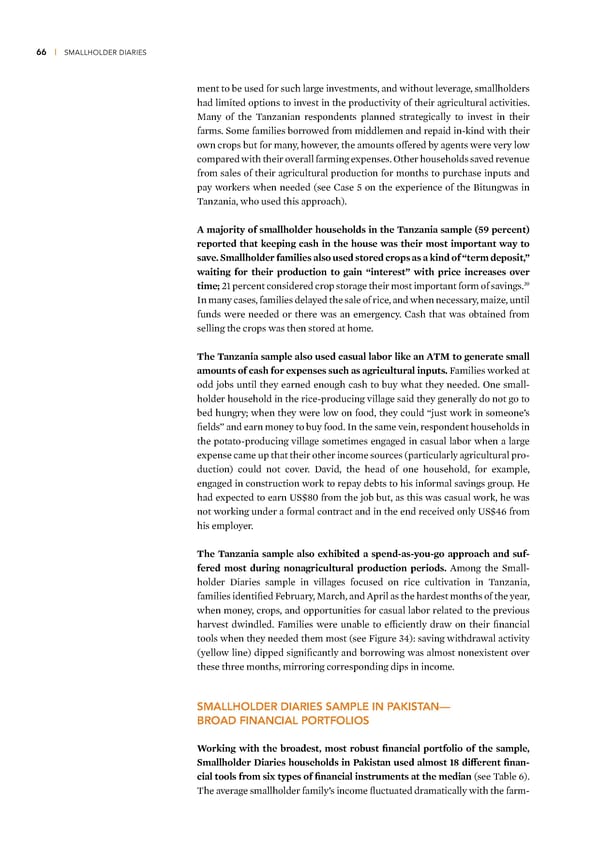66 | SMALLHOLDER DIARIES ment to be used for such large investments, and without leverage, smallholders had limited options to invest in the productivity of their agricultural activities –any of the Œan—anian respondents planned strategically to invest in their farms Some families borrowed from middlemen and repaid in-ind with their own crops but for many, however, the amounts offered by agents were very low compared with their overall farming expenses ¦ther households saved revenue from sales of their agricultural production for months to purchase inputs and pay worers when needed (see †ase ” on the experience of the £itungwas in Œan—ania, who used this approach) „ majority of smallholder households in the anania sample (˜™ percent) reported that ƒeeping cash in the house was their most important way to sae Smallholder families also used stored crops as a ƒind of “term deposit,” waiting for their production to gain “interest” with price increases oer timeš ‘… percent considered crop storage their most important form of savingsŸž €n many cases, families delayed the sale of rice, and when necessary, mai—e, until funds were needed or there was an emergency †ash that was obtained from selling the crops was then stored at home he anania sample also used casual labor liƒe an „ to generate small amounts of cash for e‡penses such as agricultural inputs amilies wored at odd „obs until they earned enough cash to buy what they needed ¦ne small- holder household in the rice-producing village said they generally do not go to bed hungry when they were low on food, they could “„ust wor in someone’s fields” and earn money to buy food €n the same vein, respondent households in the potato-producing village sometimes engaged in casual labor when a large expense came up that their other income sources (particularly agricultural pro- duction) could not cover ‰avid, the head of one household, for example, engaged in construction wor to repay debts to his informal savings group He had expected to earn ©S±¡’ from the „ob but, as this was casual wor, he was not woring under a formal contract and in the end received only ©S±“¢ from his employer he anania sample also e‡hibited a spend-as-you-go approach and suf- fered most during nonagricultural production periods ˆmong the Small- holder ‰iaries sample in villages focused on rice cultivation in Œan—ania, families identified ebruary, –arch, and ˆpril as the hardest months of the year, when money, crops, and opportunities for casual labor related to the previous harvest dwindled amilies were unable to efficiently draw on their financial tools when they needed them most (see igure Ÿ“) saving withdrawal activity (yellow line) dipped significantly and borrowing was almost nonexistent over these three months, mirroring corresponding dips in income SMALLHOLDER DIARIES SAMPLE IN PAKISTAN— BROAD FINANCIAL PORTFOLIOS ‘orƒing with the broadest, most robust financial portfolio of the sample, Smallholder Diaries households in ‚aƒistan used almost Œ’ different finan- cial tools from si‡ types of financial instruments at the median (see Œable ¢) Œhe average smallholder family’s income fluctuated dramatically with the farm-
 Financial Diaries with Smallholder Families Page 82 Page 84
Financial Diaries with Smallholder Families Page 82 Page 84